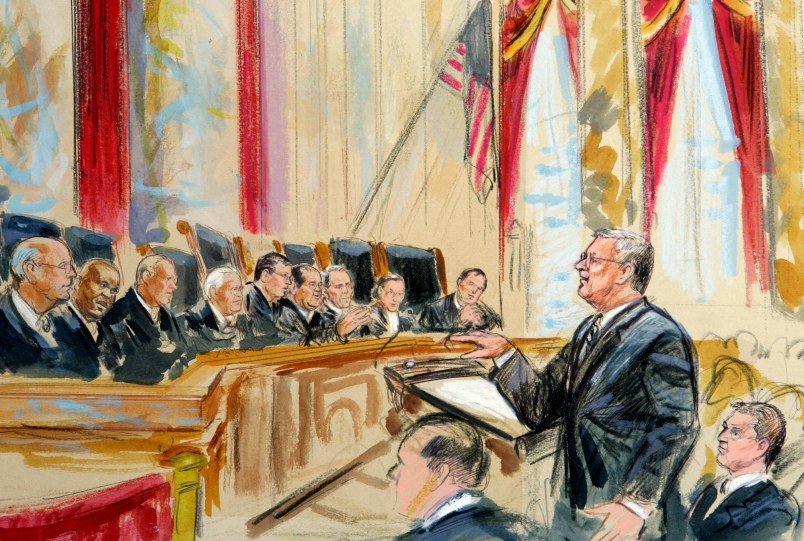WASHINGTON — Paul M. Smith keeps a cutout of a 12-year-old Washington Post newspaper article on the wall of his law office near the White House.
The headline blares, “Justices Overturn Texas Sodomy Ban.” An analysis piece just underneath it is titled, “A Debate On Marriage, And More, Now Looms.”
The paper came out the morning after Smith had won an historic victory at the Supreme Court in the case Lawrence v. Texas, which he argued before the justices on behalf of two male defendants convicted of the crime of having consensual sex in an apartment just outside Houston. State bans on consensual sodomy were decreed unconstitutional.
“People were in tears. It was certainly the most emotional experience I’ve ever had in court,” Smith tells TPM in an interview, recalling the moment on June 26, 2003, when the decision was read aloud in the chamber by its author Justice Anthony Kennedy. “It was an extremely emotional, joyous time for the gay community.”

A photo of the nearly 12-year-old article on Smith’s wall, provided to TPM.
One reason the case is a badge of honor for Smith is the monumental long-term implications of the decision, which knocked down a central legal barrier to gay rights in all its forms. It was the first time the Supreme Court had recognized the dignity of gay couples. The remaining question was how soon the holy grail of same-sex marriage would be realized.
“The roadmap was right there,” Smith says. “Once you take morality off the table and say same sex relationships are essentially the same as heterosexual relationships in peoples’ lives it’s a hard struggle to find a justification [to outlaw gay marriage].”
Twelve years later that moment seems to have arrived.
On Tuesday, the Supreme Court will hear oral arguments in the landmark case Obergefell v. Hodges about whether same-sex marriage is a constitutional right. A victory for the plaintiffs suing a group of states could wipe out all gay marriage bans in one fell swoop. The timing of the case coincides with a dramatic sea change across the country toward support for gay equality.
The case can be traced directly back to the Lawrence ruling, in which six justices ruled that the equal protection clause of the Fourteenth Amendment bans states from outlawing sodomy between consenting same-sex adults. That same principle led the Supreme Court to strike down a centerpiece of the Defense of Marriage Act by a 5-4 vote in 2013, ensuring that the U.S. government grants equal marriage benefits to gay couples.

March 6, 2015: Jim Obergefell, the named plaintiff in Obergefell v. Hodges, speaks to a member of the media after joining the Human Rights Campaign as they deliver petitions calling for nationwide marriage equality to the Supreme Court. (AP/Andrew Harnik)
“What Lawrence did is two things,” Smith says. “It said same-sex relationships are functionally the same as heterosexual relationships and serve the same functions in peoples’ lives. And it said peoples’ choices about their partner and what they’re going to do in their bedroom is something that the government can’t decide is immoral. So it took off the table the morality arguments for keeping gay people and gay relationships in a second class status.”
At the time, though, legal same-sex marriage was deeply unpopular and pushing the issue risked a backlash in the form of a constitutional amendment against it, which could have set back the cause for generations. So Smith and his legal team played it safe, actively avoiding the topic. “We were trying very hard at the time to not have the Court think about marriage,” he says. Instead he focused on the right of personal privacy in intimate sexual relations.
Today, even some conservatives on the front lines of the legal fight against gay marriage expect to lose. Paul Clement, the renowned lawyer who unsuccessfully tried to defend DOMA before the Supreme Court in 2013, admitted last fall that “it’s going to be hard to count to five votes for upholding these laws,” referring to state bans on gay marriage.
But if Lawrence planted the seed for nationwide same-sex marriage, the DOMA case U.S. v. Windsor gave it a healthy watering so it could bloom. Since then federal judges have invalidated more gay marriage bans in over two-dozen states, citing that ruling.

June 26, 2013: Gay rights advocate Vin Testa waves a rainbow flag in front of the Supreme Court on the day that the U.S. v. Windsor decision was announced. (AP/J. Scott Applewhite)
Roberta Kaplan, the lawyer who argued and won Windsor in the Supreme Court, credits Smith’s “superb” and “extraordinary” work in Lawrence a decade prior for setting the crucial precedent.
“I could never have won my case without Lawrence. There’s no question about that,” Kaplan tells TPM. “Before finding that gay people have equal dignity you first have to find that you can’t criminalize being gay. … So Lawrence was a crucial, necessary and historic step.”
As confident as she was that marriage equality was on the horizon, “I did not expect the impact to happen as quickly as it did,” Kaplan says. “That amazed me.”
The victories won by Smith and Kaplan both produced blistering dissents by Justice Antonin Scalia, who warned in the 2003 and 2013 cases that the Supreme Court’s decisions had put the United States on an inevitable road to national same-sex marriage, even if it wouldn’t admit it. Unless the Supreme Court abruptly reverses course, it’s hard to imagine a defeat for nationwide marriage equality in the upcoming case, the two lawyers said.
“Justice Scalia wrote a dissent at the time saying this was going to happen,” Smith says. “So he saw it coming and he was right.”










